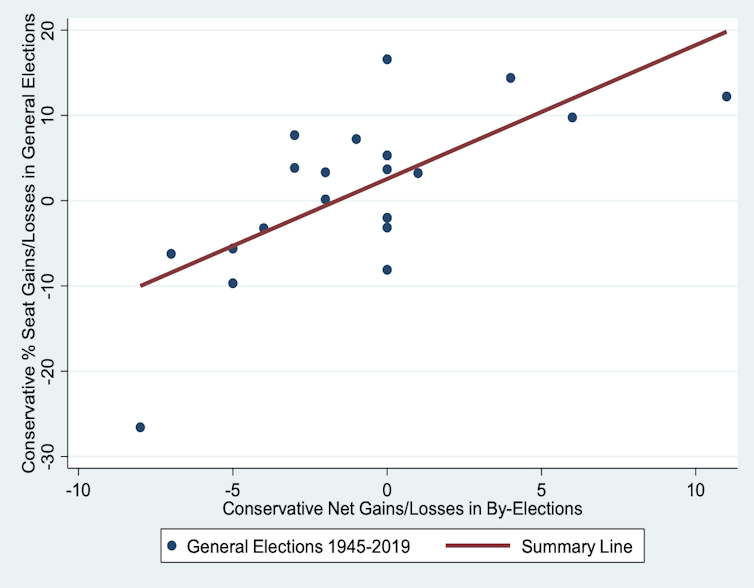The turmoil in the Conservative party unleashed by Boris Johnson’s abrupt resignation from parliament has triggered three separate byelections. The first is in the former prime minister’s London seat of Uxbridge and South Ruislip, where he had a majority of just over 7,000 votes in 2019 with Labour in second place. The second is Nigel Adams’s constituency of Selby and Ainsty, a safe North Yorkshire Conservative seat with a majority over Labour of more than 20,000. The third is Nadine Dorries’s seat of Mid Bedfordshire, which has a majority over Labour of just under 25,000 votes, making it a very safe seat.
Byelections are not generally thought to be a good guide to a party’s performance in a subsequent general election. Certainly, one can find examples of parties doing exceptionally well in byelections but not sustaining the success in a subsequent general election. The classic example of this is the Liberals’ 1962 win in Orpington. It was the first victory for the party outside the celtic fringe and the party leader, Jo Grimond, claimed that it was a major breakthrough. However, the party won only nine House of Commons seats in the 1964 general election.
More recently Labour retained Peterborough in a byelection in June 2019, even though it lost just over 17% of its vote share in comparison with the previous election in 2017. The Conservatives lost almost 26% of their vote share, much of it captured by the Brexit party. So while Labour held on to the seat this result proved to be no guide to the general election in December of that year, which the party lost badly.
However, the argument that byelections are no guide to general elections is not true if one looks at a lot of them. To see this, we can examine the Conservative party’s performance in all 474 byelections held in the UK since 1945 and compare them with its performance in subsequent general elections. A large majority of these byelections involved no change of party, something which occurred in 367 (77%) of the contests held over this period.
Byelections over the years
The chart shows net gains in byelections since 1945 for the Conservatives compared with net gains in House of Commons seats in subsequent general elections. The relationship between these is very strong (r=0.70). The data for this exercise comes from the House of Commons library.
To illustrate this with an example, during the Labour government of 1974 to 1979 there were a total of 30 byelections. Of these, 23 returned candidates from the same political party and the Conservatives won six of the remainder with the Liberals winning the seventh. Subsequently, Margaret Thatcher won the 1979 general election with a majority of 44 seats. A good byelection performance for the party preceded a good general election performance.
Conservative net gains in byelections compared with net gains in seats in subsequent general elections 1945 to 2019

We can use byelection gains to predict increases in seats in the House of Commons in general elections in Britain. The modelling shows that a net win of one byelection by the Conservatives predicts an increase of 1.5% in the number of seats the party wins in a general election. This translates into just over nine extra seats in the House of Commons. Equally a net loss of a byelection reduces their House of Commons seat share by the same amount. This exercise is of course subject to errors, since the relationship is not perfect.
If we look at the same relationship for Labour, then it is weaker than for the Conservatives, but it is still highly statistically significant (r=0.5). This means that a net gain of one seat by the party in a byelection translates into an additional seven seats in the House of Commons. The Liberal Democrat relationship is very similar to that of Labour (r=0.51).
Since the 2019 general election there have been 13 byelections in Britain, eight of them with no change of party. As regards the remaining five, Labour lost Hartlepool to the Conservatives, but subsequently won Wakefield from them, so the party had a net gain of zero.
In contrast, the Liberal Democrats won three byelections from the Conservatives in Chesham and Amersham, North Shropshire and Tiverton and Honiton. The party did not have any byelections in its own seats, so the net gain for the party is three seats. This points to a strong revival of Liberal Democrat seats in the House of Commons after the next election.
Labour has a good chance of winning the Uxbridge and South Ruislip byelection, but the other two seats are going to be tough nuts to crack. However, if either of them are captured by Labour or by the Liberal Democrats, it will be a disaster for Rishi Sunak’s government.
Paul Whiteley has received funding from the British Academy and the ESRC
This article was originally published on The Conversation. Read the original article.







